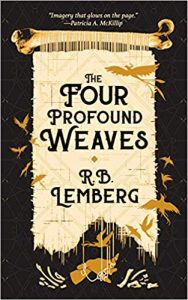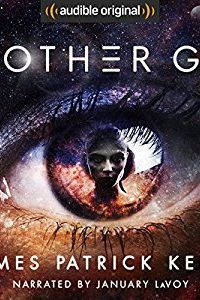Gary K. Wolfe Reviews The Four Profound Weaves by R.B. Lemberg
 The Four Profound Weaves, R.B. Lemberg (Tachyon 978-1-61696-334-7, $14.95, 192pp, tp) September 2020.
The Four Profound Weaves, R.B. Lemberg (Tachyon 978-1-61696-334-7, $14.95, 192pp, tp) September 2020.
For nearly a decade, R.B. Lemberg has been developing their Birdverse world in a number of stories and poems, and I confess to having seen only a handful of them prior to reading their first novel The Four Profound Weaves. But the novel provides most of what you need to know about this universe, which worships the god Bird and Bird’s “hidden brother Kimri,” who serves as a men’s god for some of the tribes and alliances that make up this rather sparse desert world. Lemberg was, as I recall, the only author to become a finalist for the Crawford fantasy award on the basis of a volume of poetry (Marginalia to Stone Bird), and it’s apparent from the outset that their novel is the work of a poet. The prose is lyrical, evocative, and precise, and it soars when it needs to, without ever yielding to coloratura dramatics.
That’s not the only thing appealing, and even refreshing, about this remarkable novel. For one thing, Lemberg demonstrates how it’s possible to construct an evocative and expansive setting without the need for hundreds of pages of arduous, stone-by-stone worldbuilding, and how, by doing this, the setting becomes a function of the tale, rather than the other way around. For another, they populate this tale with a fascinating mix of characters of various gender identities, including nonbinary children (one narrator’s grandchild is “neither a boy nor a girl”; others are referred to as “in-between”). Of the two alternating narrators, one has only recently transitioned to being a man, while the other reveals that she transitioned to female at a much younger age. (Transitioning in this world, however, seems a good deal simpler than in our own, involving magical “sandbirds” forming a cocoon around the body.) What may be even more unusual than Lemberg’s genderqueer and nonbinary characters, though, is that both of the narrators, who end up setting off on a hazardous quest, are elderly, at least in their sixties. They not only have to battle some fearsome enemies and survive vampiric “diamondflies,” but can feel pretty stiff just getting up in the morning. Unlike the Gandalfian wizards and folkloric Wise Women who serve to represent aging in much of fantasy, they’re actually dealing with the fears and realities of growing old.
Uiziya is a carpet weaver who has waited 40 years for the return of her aunt Benesret, who had promised to teach her the Four Profound Weaves that are the pinnacle of the profession: carpets woven from wind, signifying change; from sand, signifying wanderlust; from song, signifying hope; and from bones, signifying death. These weaves also provide the titles for the four sections of Lemberg’s tale. In the first, a narrator initially called the nameless man returns to the desert settlement of Snake-Surun’ hoping that his old friend from decades earlier – Benesret, again – will give him a name and perhaps an identity. His entire life has been defined by his outsider status: his people, the Khana, are restricted to a kind of ghetto in the city of Iyar, and even within that ghetto male and female communities are segregated, with no recognition of “in-betweeners” – “they insisted that the shape of one’s body determined one’s fate.” Having always identified as male, the nameless man can’t even visit the male district of his own district, while his grandchildren seem nonplussed that their grandmother has become their grandfather. When the nameless man learns from Uiziya that Benesret has been gone for decades, he persuades her join him in searching for her.
Even though they’re attacked en route by a would-be assassin, it doesn’t take them that long to track down Benesret (again a model of narrative efficiency; another writer might have devoted a whole volume to that search), but the result isn’t quite what they’d hoped for. Uiziya is seriously injured, and the nameless man – now called nen-sasaïr – must try to find a “physicker” in the city of Iyar. This in turn brings them to the attention of the dictatorial Ruler of Iyar, ominously nicknamed the Collector and about the closest Lemberg gets to a formulaic figure, a nasty villain cut from the Vader/Voldemort template, although his habit of moving about inside a cage is a nicely symbolic touch. The action, both literally and figuratively, gets much darker as the scene shifts to vast underground catacombs under the city and as the pair gamely face off against assassins, torturers, and pretty much the worst mayor ever. For once, these aren’t whip-smart kids learning to be gods or kings, but complex, experienced older adults recognizing and acting on what a lifetime has taught them about resistance, redemption, and loyalty. If that isn’t rarity enough, Lemberg’s gorgeous prose sets The Four Profound Weaves apart as one of the most beautifully written fantasies of the year.
Gary K. Wolfe is Emeritus Professor of Humanities at Roosevelt University and a reviewer for Locus magazine since 1991. His reviews have been collected in Soundings (BSFA Award 2006; Hugo nominee), Bearings (Hugo nominee 2011), and Sightings (2011), and his Evaporating Genres: Essays on Fantastic Literature (Wesleyan) received the Locus Award in 2012. Earlier books include The Known and the Unknown: The Iconography of Science Fiction (Eaton Award, 1981), Harlan Ellison: The Edge of Forever (with Ellen Weil, 2002), and David Lindsay (1982). For the Library of America, he edited American Science Fiction: Nine Classic Novels of the 1950s in 2012, with a similar set for the 1960s forthcoming. He has received the Pilgrim Award from the Science Fiction Research Association, the Distinguished Scholarship Award from the International Association for the Fantastic in the Arts, and a Special World Fantasy Award for criticism. His 24-lecture series How Great Science Fiction Works appeared from The Great Courses in 2016. He has received six Hugo nominations, two for his reviews collections and four for The Coode Street Podcast, which he has co-hosted with Jonathan Strahan for more than 300 episodes. He lives in Chicago.
This review and more like it in the August 2020 issue of Locus.
©Locus Magazine. Copyrighted material may not be republished without permission of LSFF.
 While you are here, please take a moment to support Locus with a one-time or recurring donation. We rely on reader donations to keep the magazine and site going, and would like to keep the site paywall free, but WE NEED YOUR FINANCIAL SUPPORT to continue quality coverage of the science fiction and fantasy field.
While you are here, please take a moment to support Locus with a one-time or recurring donation. We rely on reader donations to keep the magazine and site going, and would like to keep the site paywall free, but WE NEED YOUR FINANCIAL SUPPORT to continue quality coverage of the science fiction and fantasy field.







